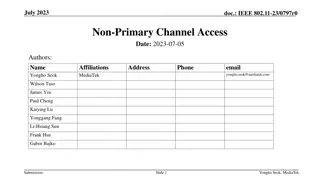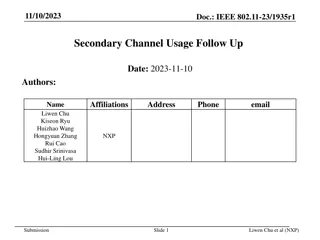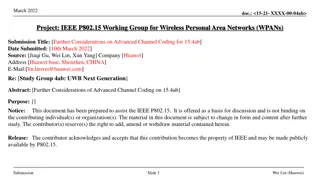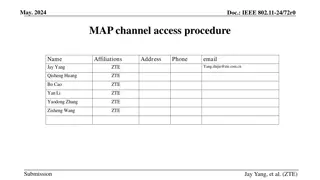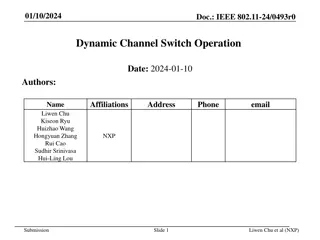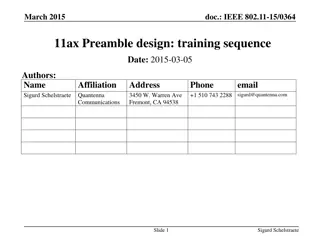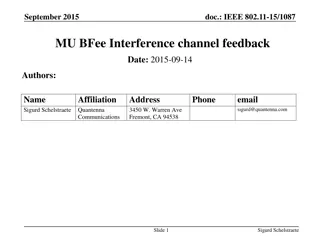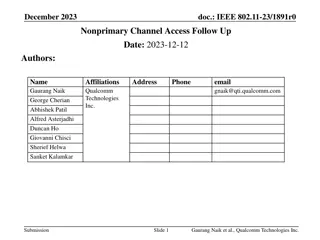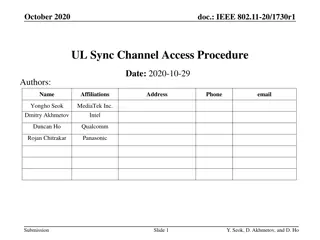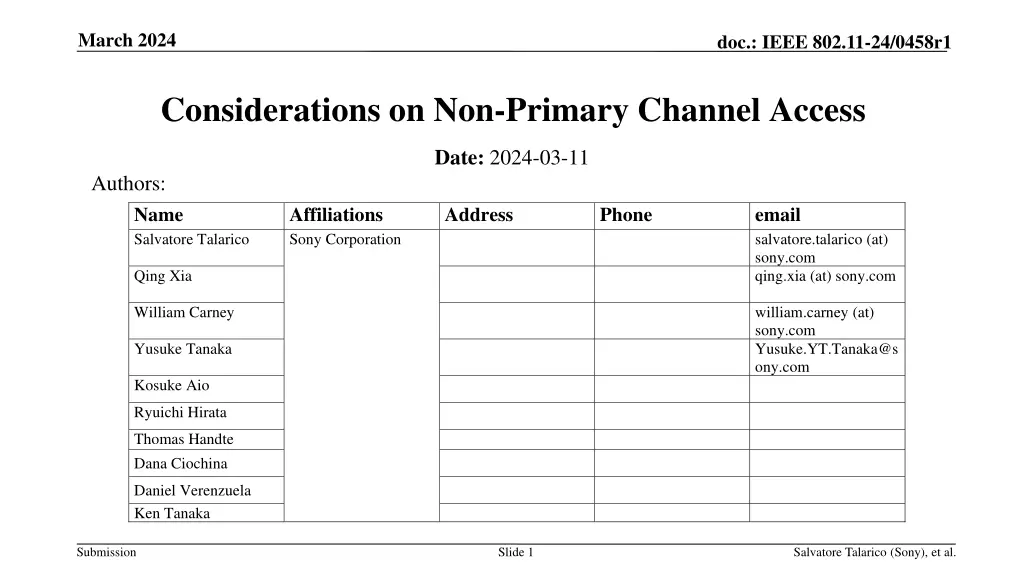
Enhancing Multi-Channel Transmission in IEEE 802.11be: Considerations on Non-Primary Channel Access
Explore the challenges in multi-channel transmission caused by primary channel blocking in IEEE 802.11be technology. Learn about the concept of preamble puncturing and the proposed solution of non-primary channel access (NPCA) to optimize system reliability and bandwidth utilization. Delve into regulatory restrictions and design considerations to address these issues effectively.
Download Presentation

Please find below an Image/Link to download the presentation.
The content on the website is provided AS IS for your information and personal use only. It may not be sold, licensed, or shared on other websites without obtaining consent from the author. If you encounter any issues during the download, it is possible that the publisher has removed the file from their server.
You are allowed to download the files provided on this website for personal or commercial use, subject to the condition that they are used lawfully. All files are the property of their respective owners.
The content on the website is provided AS IS for your information and personal use only. It may not be sold, licensed, or shared on other websites without obtaining consent from the author.
E N D
Presentation Transcript
March 2024 doc.: IEEE 802.11-24/0458r1 Considerations on Non-Primary Channel Access Date: 2024-03-11 Authors: Name Salvatore Talarico Affiliations Sony Corporation Address Phone email salvatore.talarico (at) sony.com qing.xia (at) sony.com william.carney (at) sony.com Yusuke.YT.Tanaka@s ony.com Qing Xia William Carney Yusuke Tanaka Kosuke Aio Ryuichi Hirata Thomas Handte Dana Ciochina Daniel Verenzuela Ken Tanaka Submission Slide 1 Salvatore Talarico (Sony), et al.
March 2024 doc.: IEEE 802.11-24/0458r1 Introduction In 802.11be the concept of preamble puncturing has been introduced with the aim to improve the spectrum utilized for multi-channel transmission However, blocking of the primary channel still represents the bottleneck in terms of system reliability as large portions of the bandwidth may be left unused if interfering transmission (e.g., OBSS or other incumbent technology) overlaps with that channel. This issue becomes particularly detrimental as bandwidth used is larger (e.g., 160 or 320 MHz). Submission Slide 2 Salvatore Talarico (Sony), et al.
March 2024 doc.: IEEE 802.11-24/0458r1 State of Art - Review Due to this issue, current deployments tend to be provisioned and planned with orthogonal narrower bands Quite complex procedure which is far from optimal as it leads to lower maximum throughput that what potentially supported. To mitigate this issue, concept of non-primary channel access (NPCA) has been proposed [1] The basic concept is to utilize different operational channel(s) to serve as alternative primary channel when this is found to be busy after EDCA procedure so other operational channels that are idle could be utilized. Many design principles and high-level concepts have also been disclosed (e.g., [1-16]), and general procedure and feature has been well motivated by thorough simulation campaigns (e.g. [5, 8-9]). Submission Slide 3 Salvatore Talarico (Sony), et al.
March 2024 doc.: IEEE 802.11-24/0458r1 Regulatory Restrictions (1/2) Due to means of some regulatory requirements such as ETSI BRAN [17-18], the NPCA design is currently subject to some constraints unless some relaxations are applied: Regardless of whether a primary or non- primary channel is used EDCA must be performed on those channels, while PIFS CCA is sufficient for the other operating channels. When switching from or to the primary or non-primary channel a device must retain the use of that channel for at least 1 second. Submission Slide 4 Salvatore Talarico (Sony), et al.
March 2024 doc.: IEEE 802.11-24/0458r1 Regulatory Restrictions (2/2) Due to means of some regulatory requirements such as ETSI BRAN [17-18], the NPCA design is currently subject to some constraints unless some relaxations are applied: Groups of adjacent channels for the 6 GHz Band Groups of adjacent channels for the 5GHz Band Submission Slide 5 Salvatore Talarico (Sony), et al.
March 2024 doc.: IEEE 802.11-24/0458r1 Coexistence Considerations Multi-channel transmission is affected by OBSS transmissions overlapping with the primary channel Basic NAV timer is available and TxOP length information in retrievable Overlapping transmissions from adjacent deployment of a variety of other technologies (e.g., LAA and NR-U) No interoperability is possible, and no NAV timer is available Carrier aggregation and wideband transmissions is supported in multiple features E.g., NR-U supports wideband transmission starting from Rel.16 [17] Wideband transmissions in dynamic channel access for eMBB (3GPP 37.213 Sec. 4.1.6) Wideband transmission in semi-static channel access for URLCC (3GPP 37.213 Sec. 4.3.3) Wideband transmission operation for Sidelink (3GPP 37.213 Sec. 4.5.6) For these technologies, the design is not regulation agnostic, and it is possible to enable and disable some features or functionalities based on deployment and regional requirements. When designing NPCA, co-existence with OBSS and presence of other incumbent technologies should be considered. Submission Slide 6 Salvatore Talarico (Sony), et al.
March 2024 doc.: IEEE 802.11-24/0458r1 General Design Considerations Before performing any switching, a STA may need to know capabilities of the devices with which it indents to communicate with together with the channel status of the non-primary channel A single non-primary channel of 20 MHz bandwidth should be defined Implementation complexity and power saving are important metrics to consider. Legacy multi-channel channel access procedure could be reused Backoff among primary and non-primary channel should be independently handled. ED threshold value should be adapted based on the actual set of operating channels associated with the non-primary channel and overlapping OBSS transmission on the primary channel. When switching from non-primary to primary channel both regulatory requirements and overall co-existence should be accounted for To account for legacy devices and devices that may be in idle mode, return to a primary channel should be done at the earliest convenience by also accounting for the device capability switching time and available information (e.g., OBSS Basic NAV, and related timer) The switch between primary and non-primary cannot occur earlier than one second (if regulatory constrains must be met), unless the primary and non-primary channel belong to different groups of adjacent channels, which may partially overlap with each other. Submission Slide 7 Salvatore Talarico (Sony), et al.
March 2024 doc.: IEEE 802.11-24/0458r1 Signaling To properly enable NPCA a STA should at least indicate the following information: Capability of supporting NPCA AP and non-AP STA should be both NPCA capable. Whether NPCA is enabled or disabled If AP indicates NPCA is disabled, non-AP STA should not switch to NPCA enabled If AP indicates NPCA is enabled, it is up to non-AP STA to enable or disable NPCA NPCA is only enabled when all communicating devices within a BSS are NPCA capable. TxOP length If OBSS basic NAV timer is available, TxOP for NPCA is truncated to align with OBSS s TxOP and switch to primary channel is performed with a minimum switching time that depends upon whether the primary and non-primary belong to separate groups of adjacent channels. If OBSS basic NAV is not available, truncation of the TxOP may free resources for other technologies to use, which is not needed. Switch Delay Indicate the required time to switch from one channel to another to avoid ambiguity across AP and non-AP STAs in terms of the returning time into the primary channel or switching to the non-primary channel. At least for the switching from primary to non-primary channel, both AP and non-AP STA should expect to switch at the same time regardless of different switching delays associated to different devices. Submission Slide 8 Salvatore Talarico (Sony), et al.
March 2024 doc.: IEEE 802.11-24/0458r1 Summary For multi-channel operation, the use of non-primary channel access (NPCA) is beneficial to mitigate the poor spectrum utilization that occurs when a primary channel is blocked by external interference. When designing NPCA both regulatory constrains and co-existence with both OBSS and other incumbent technologies should be considered, and aim should be to develop a simple yet effective procedure: Legacy multi-channel channel access procedure is reused A single non-primary channel of 20 MHz bandwidth is defined Switching from non-primary to primary channel should account for a 1 second constrain and should distinguish the case when the basic NAV is available with the case when this is not available. To support this feature a STA should indicate at least the following information: i) Capability of supporting NPCA; ii) Whether NPCA is enabled or disabled; iii) TxOP length; iv) Switch Delay from non-primary to primary channel. Submission Slide 9 Salvatore Talarico (Sony), et al.
March 2024 doc.: IEEE 802.11-24/0458r1 References [1] IEEE 802.11-23/34, Non-primary channel utilization, Sindhu Verma [2] IEEE 802.11-23/631, Secondary channel usage and secondary 20MHz channel backoff, Liwen Chu [3] IEEE 802.11-23/797, Non-primary channel access, Yongho Seok [4] IEEE 802.11-23/961, UHR secondary channel access, Minyoung Park [5] IEEE 802.11-23/962, Performance evaluation of non-primary channel access , Dibakar Das [6] IEEE 802.11-23/1112, Thoughts on secondary channel access, Insun Jang [7] IEEE 802.11-23/1365, Discussions on non-primary channel access, Sanghyun Kim [8] IEEE 802.11-23/1891, Nonprimary Channel Access Follow-Up , Gaurang Naik [9] IEEE 802.11-23/1892, Thoughts on Dynamic Subchannel Operation , Gaurang Naik [10] IEEE 802.11-23/1911, Secondary channel access and frame transmission, Dongju Cha [11] IEEE 802.11-23/1913, Secondary channel access operation, Dongju Cha [12] IEEE 802.11-23/1935, Secondary channel usage follow up, Liwen Chu [13] IEEE 802.11-23/1951, Concurrent CCA for non-primary channel access, Leonardo Lanante [14] IEEE 802.11-23/2005, Non-Primary Channel Access (NPCA) , Minyoung Park [15] IEEE 802.11-23/2023, Further Discussion on Non-Primary Channel Access , Sindhu Verma [16] IEEE 802.11-23/2039, Secondary channel usage follow up, Liwen Chu [17] ETSI BRAN 301.893, 5 GHz RLAN; Harmonised Standard covering the essential requirements of article 3.2 of Directive 2014/53/EU . [18] ETSI BRAN 303.687, 6 GHz WAS/RLAN; Harmonised Standard for access to radio spectrum . [19] 3GPP TS 37.213, 3rd Generation Partnership Project; Technical Specification Group Radio Access Network; Physical layer procedure for shared spectrum channel access . Submission Slide 10 Salvatore Talarico (Sony), et al.
March 2024 doc.: IEEE 802.11-24/0458r1 Straw Poll 1 Do you support to define a Secondary Channel Access (SCA) mechanism which allows a STA to transmit on the idle secondary channel(s) if the STA finds primary channel to be unavailable now or later under TBD conditions? Submission Slide 11 Salvatore Talarico (Sony), et al.
March 2024 doc.: IEEE 802.11-24/0458r1 Straw Poll 2 Do you agree that an AP supporting Secondary Channel Access (SCA) announces one non-primary channel that performs channel access for SCA? The non-primary channel is one of 20MHz channel in its BSS Operating Channel Width More than one non-primary channel is TBD Detailed signalling is TBD Submission Slide 12 Salvatore Talarico (Sony), et al.



